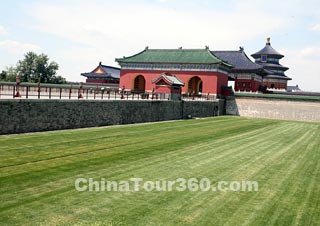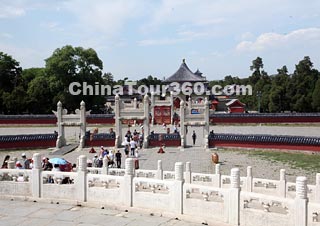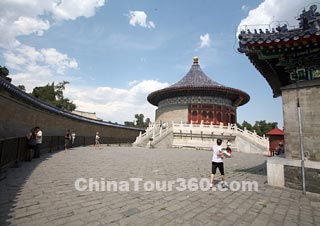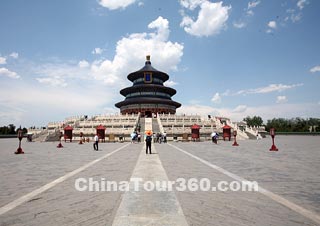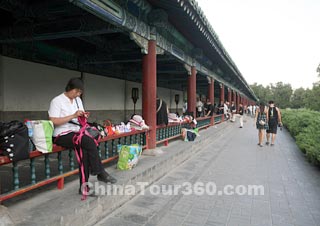Self-guided Temple of Heaven Tour
"In-depth Temple of Heaven"
- Code: TH02
Being a culturally, historically and artistically featured sight of interest, the Temple of Heaven is acclaimed as the largest and most venerable building complex for sacrificial offerings to Heaven during the Ming and Qing dynasties in China. It has been admired by visitors from all over the world and some of them even go there twice or more to further explore its essence in depth. If you have plenty of time, here we propose a more complete Temple of Heaven travel route.
|
|
The South Gate and North Gate are the main entrances to the Temple of Heaven. No matter which entrance you take, the first part of your Temple of Heaven tour should be focusing on attractions along the construction axis as what we have specified in the previous tour route. Now we would like to offer you the brief route starting from either the South Gate or the North Gate for this part.
Option one:
South Gate - Enclosed Walls of the Circular - Circular Mound Altar - Kitchen for Sacrifice - Echo Wall - Imperial Vault of Heaven - Chengzhen Gate - Nine-Dragon Cypress - Vermilion Steps Bridge (Danbiqiao) - East Annex Hall - West Annex Hall - Hall of Prayer for Good Harvests
Option two:
North Gate - Hall of Prayer for Good Harvests - East Annex Hall - West Annex Hall - Vermilion Steps Bridge (Danbiqiao) - Nine-Dragon Cypress - Chengzhen Gate - Imperial Vault of Heaven - Echo Wall - Kitchen for Sacrifice - Circular Mound Altar - Enclosed Walls of the Circular
If you take the option one, you can exit from the west gate of the Hall of Prayer for Good Harvests and continue the tour westward. If you follow the option two, you could leave the Enclosed Walls of the Circular from its south gate and move westward. Both of them will lead you to the Palace of Abstinence in a few minutes' walking.
|
|
With a western exposure, a double encircling wall and a double moat, the Palace of Abstinence was the place where the Ming and Qing emperors made their ablution before performing the heaven-worshipping rites at the inner part of the Temple of Heaven. During the three days’ ablution, the emperors would keep themselves away from meat, alcohol, entertainment, state affairs and ladies. Buildings inside the Palace of Abstinence are the Beamless Hall (namely main hall), Bedroom Hall, Belfry and Duty Rooms. Two stone pavilions stand on the terrace in front of the Beamless Hall; the larger one on the left has a 1.5 meters tall bronze statue which symbolizes justice and righteousness, and the smaller one on the right has a board engraved with the time of all the sacrificial rites in a year. Consisting of five rooms, the Beamless Hall, as it is termed, has arched structure roof built without beam, post or even a single wood. It is hence one of the architectural masterpieces in the Temple of Heaven. Except for the room in the middle which has a throne and other original articles used by the Qing emperors in it, the rest four rooms of Beamless Hall now are opened to display antiquities and historical documents relating to the abstinence. The Bedroom Hall is behind the main hall, and the Duty Rooms are on both sides of the main hall. For the Belfry, it is two-storied and situated in the north-eastern corner of the Palace of Abstinence. Surrounded by such a peaceful and secluded place, you can explore the mystery of the royal sacrificial culture from both the groups of buildings and the various precious exhibitions.
After visiting the Palace of Abstinence, you can make your way out from its south gate and move westward to the Administration of Ceremonial Music. Here the musicians and dancers were trained for ceremonial music which was performed during the heaven-worshipping ceremonies. Initially named Temple of Ceremonial Music during the Ming and early Qing dynasties, there were more than 600 musicians and dancers who were Taoists in it all year round. At that time, the temple had cornered almost all the religious and sacrificial rites in Beijing, and those Taoists even run teahouses and wine shops in the temple, consequently these practices put the temple into a bad ethos. Later Emperor Qianlong in the Qing Dynasty dismissed the Taoists so as to get rid of the vicious effects. From then on, it was renamed the Administration of Ceremonial Music, also the musicians and dancers were all drawn from scions of Manchu eight banners. The main buildings here you could see include the Ningxi Hall, Xianyou Hall and Exhibition Halls of Royal Music.
|
|
As the main hall of the Administration of Ceremonial Music, Ningxi Hall was the place where ritual music instruments were kept and the music was rehearsed. In addition to the various exhibitions, you could also have the chance to enjoy the performance of ancient ritual music during your visit. Xianyou hall, being served as the gown storage, is just behind Ningxi Hall. At present, it has been turned into memorial hall of ancient Chinese musicians with their statues, stories and mural paintings being displayed. Stepping into the Exhibition Halls of Royal Music, you will marvel at the rich collections of antiquated music instruments, some of which you probably have never seen. Not only can you learn the instruments and their knowledge, but you can also play them. For a lover of music, it will be a fresh and exciting experience to visit this spot.
Your Temple of Heaven tour now comes to an end. It is quite easy for you to find the way to exit from the West Gate of the temple.
- More Self-guided Temple of Heaven Tours:
- Construction Axis of Temple of Heaven
- Beijing Tours including the visit to Temple of Heaven:
- Essence of Beijing: 5-Day Beijing Tours
- Best China Tours: 10-Day Beijing - Xian - Guilin - Yangshuo - Guilin - Shanghai
- Essence of China: 8-Day Small Group of Beijing - Xian - Shanghai



